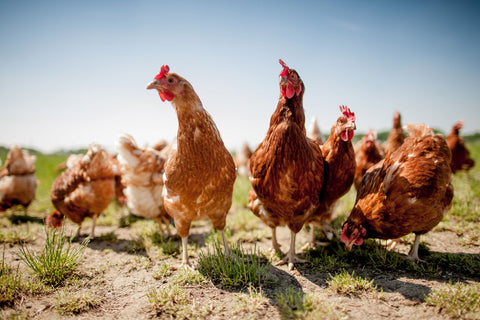When you think of free range chickens, maybe you have this picture in your mind of open stretched fields with a bright leafy horizon and chickens clucking in their clicks as far as the eye can see. This image of happy chickens pecking and foraging through unlimited grassy pastures is much more humane for our feathery friends, but what actually is considered free range?
In New Zealand the code of Welfare states that you can keep 9 chickens per square metre inside the coop as long as they have access to the outdoors to qualify as free range. The area for the chickens to roam outside must not exceed 1 hen per 4 square metres.
There are various standards laid out by the Codes of Welfare to ensure the welfare of laying hens and meat chickens. Commercial farmers are held accountable to adhere to these codes and are monitored by regulatory authorities who govern the poultry industry.

What does free range mean?
Under New Zealand law, layer hens are considered free range as long as they have access to the outdoors and abide by the stocking densities laid out in the Code of Welfare. Within commercial chicken farms, hens are either kept in cages, colony cages or barns. When they are kept in barns with access to the outdoors through evenly spread openings called pop-holes, they fall under the category of free range chickens.
The chicken range should be an outdoor area with dry grassland and other shrubbery. Chickens love dust and sand for bathing. They also love to forage for worms and other interesting insects and will feel safer doing so under the cover of foliage or trees. If the outdoor space you provide for your chickens is made up of wet mud, they won’t want to spend their time outdoors. Mud is also a breeding ground for bacteria and parasites.
In reality, the term ‘free range’ is very similar to barn-raised chickens with the added benefit of having access to the outside. If your neighbouring farm has tons of acreage for them to roam free with no threat of predators, then maybe that romantic image has some credibility. However, most large egg productions follow the outlines of the law as close as they can get away with. If we want to preserve our mental image of frolicking free range chickens, isn’t it much better to have your own happy hens at home?

How much space does a free range chicken have?
Large egg production companies follow the outlines of the law whether they are considered free range chickens or caged hens. Most egg laying hens considered free range in commercial farms, are roaming outside with 2,500 of their feathery friends per hectare. This is the maximum density considered free range set by the NZ Code of Welfare.
Indoor stocking density for free range chickens is set at 9 hens per square metre by the NZ code of Welfare and the pop-holes, which are openings between the chicken coop shed and the outside must be at least 35 centimetres high and 40 centimetres wide. They also need to be evenly spaced along the side of the building to allow free access to the chickens without risk of smothering or injury.
GET A FREE COPY OF OUR CATALOGUE
How much space do 6 chickens need?
With the recent surge of small backyard domestic chicken owners popping up across New Zealand we’re hoping this means our chooks are starting to live their best lives more often in spacious and safe dwellings.
Chickens are social beings and love to be around their fellow folk, but we all desire a little space to roam sometimes. There is often one or two in the pack who may have aggressive or dominant tendencies. If this is the case, your flock may experience feather pecking. This is when one chicken pecks or pulls out the feathers of other flock members due to stress, and it generally happens when they are confined to small spaces. At least if there’s somewhere the other birds can roam, they can create distance from aggressive birds.
If your coop becomes too crowded you’ll likely encounter health issues with your chooks. Diseases and parasites can spread quickly in confined spaces. Our blog What Does a Chicken Coop Need outlines everything you need inside your coop to keep your chooks healthy and happy.
Whether you have 6 hens or 6,000 hens, the minimum standards of space outlined in the codes of welfare will apply. If you’re keeping 6 chickens in a coop, you’ll need at least 0.6 square metres of space inside the coop and at least 24 square metres of space in your chicken run. Remember, this is only the advised minimum space you’ll need for your chickens, if you have the ability to give them access to a larger space while keeping them safe from predators and the elements - they’ll love you for it.
At Outpost Buildings we have a wide range of high quality chicken coops and hen houses to house your happy hens. From small backyard shelters to commercial free-range hen house designs.

Do chickens like being free range?
Chickens have evolved from jungle fowl. This means that they love to forage, peck and run around in outdoor spaces. However, they aren’t birds that love big open spaces, their ancestors would have stuck to foraging under the tree canopies, out of the swooping reach of birds of prey.
How would you feel cooped up inside your house all day everyday? The truth is, just like any other animal, they love to roam free as long as there is no sense of danger. Ideally, an area covered with trees or other foliage will provide a level of protection or a ‘safety net’ for your chooks. Fortunately, they do have a homing nature, which means once they’re ready for a rest or a bite to eat, they’ll wander back to the coop to re-coop-erate!
Chickens love to scratch up the dirt or peck at the ground in search of grubs or worms to munch on. They also like to sunbathe with their wings spread open and dust bathe in the dirt to clean themselves. In nature, they would perch on branches at night to rest out of reach of predators.
There’s no doubt that if you make your chicken run a safe and healthy place for your flock to be, they will be jumping out the coop door as soon as it’s opened in the morning.

Can chickens stay in the coop all day?
If the weather is not cooperating; there’s howling winds, torrential rain or a hot beating sun, the likelihood of your chickens preferring to stay inside the coop to optimise comfort is high. Yes, you can keep your chickens inside the coop all day if needed.
If you’re keeping your chickens inside the coop all day just make sure that they have all of the provisions they need to thrive. Clean water, plenty of food, warm, dry bedding and good ventilation will make them more comfortable and willing to stay inside.
If you’re looking at raising some chickens and you're a beginner to egg farming then check out our blog outlining Things you need to know before you get chickens, which includes the necessary steps towards healthy, happy chicken farming.
Any additional questions? Feel free to contact one of the team here at Outpost Buildings.





